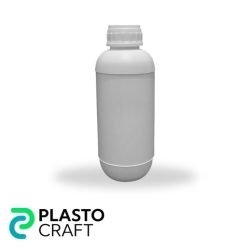
HDPE ABS Jar
| Specification | Detail |
|---|---|
| Capacity | 1200 Gram |
| Height | 7 Inches |
| Ground | 13 Inches |
Minimum Order Quantity 500
In the ever-evolving world of product packaging, the HDPE ABS jar represents an innovative solution that combines the robustness of High-Density Polyethylene (HDPE) with the versatility of Acrylonitrile Butadiene Styrene (ABS). This article explores the features, benefits, applications, and environmental impact of HDPE ABS jars, shedding light on how this packaging solution has gained prominence in various sectors.
Understanding HDPE ABS Jars
HDPE ABS jars are containers crafted by blending two thermoplastic materials: High-Density Polyethylene (HDPE) and Acrylonitrile Butadiene Styrene (ABS). HDPE offers strength, durability, and chemical resistance, while ABS brings impact resistance, dimensional stability, and toughness to the mix. This fusion results in a superior jar with a myriad of applications across industries.
The Synergy of HDPE and ABS
Strength and Durability: HDPE ensures high strength and durability, allowing the jar to endure various handling conditions during transportation and storage without compromising product integrity.
Impact Resistance: ABS enhances the jar’s impact resistance, making it less prone to cracks and breakage. This property is especially valuable for products requiring extra protection during transit.
Chemical Stability: The combination of HDPE and ABS imparts chemical stability to the jar, making it suitable for a wide range of products, from food items to pharmaceuticals and household chemicals.
Dimensional Stability: ABS contributes to the jar’s dimensional stability, ensuring it maintains its shape and size over time, even in varying environmental conditions.
Advantages of HDPE ABS Jars
Versatility: HDPE ABS jars are versatile and can package various products across industries, including food, pharmaceuticals, personal care, cosmetics, and household chemicals.
Customizable Design: The blend of HDPE and ABS allows for a customizable design, including different shapes, sizes, and colors to meet specific branding requirements.
Tamper-Resistant: The combination of HDPE and ABS provides an added layer of tamper resistance, ensuring the integrity and safety of enclosed products.
Eco-Friendly Properties: Both HDPE and ABS are recyclable materials, contributing to a more sustainable packaging ecosystem.
Applications of HDPE ABS Jars
Food and Beverage Industry: HDPE ABS jars are ideal for packaging food products like condiments, sauces, dressings, nuts, and spices. The jar’s robustness and chemical resistance make it a reliable choice for preserving food freshness.
Pharmaceutical and Healthcare Products: The durability and tamper-resistant properties of HDPE ABS jars make them suitable for packaging pharmaceuticals, vitamins, supplements, and ointments, ensuring the safe storage of sensitive medical products.
Personal Care and Cosmetics: In the personal care and cosmetics industry, HDPE ABS jars are used for packaging creams, lotions, gels, and beauty products, offering customizable and aesthetically appealing packaging.
Household and Cleaning Products: HDPE ABS jars find applications in packaging household and cleaning products, including liquid detergents, dishwashing liquids, and surface cleaners. The jars’ impact resistance ensures the safe storage and transport of potentially corrosive substances.
Environmental Considerations
Recyclability: HDPE and ABS are recyclable materials, enabling manufacturers and consumers to participate in recycling initiatives to reduce plastic waste.
Sustainable Sourcing: Using recycled HDPE and ABS or exploring bio-based alternatives can further minimize the environmental impact of HDPE ABS jars.
Consumer Education: Educating consumers about the importance of recycling and responsible plastic usage can encourage environmentally-conscious behaviors.
Challenges and Sustainable Solutions
Single-Use Plastics: As with any plastic packaging, the challenge of single-use plastics persists. Manufacturers can explore reusable or refillable options to minimize waste.
Circular Economy Initiatives: Collaboration between manufacturers, consumers, and recycling facilities is essential to establishing an efficient circular economy for HDPE ABS jars.
Biodegradable Alternatives: Continued research and development in biodegradable plastics offer a potential solution to reduce the environmental impact of traditional HDPE ABS jars.
Conclusion
HDPE ABS jars embody the best of both worlds in packaging – the strength of HDPE and the versatility of ABS. This hybrid combination provides a superior packaging solution with excellent impact resistance, dimensional stability, and chemical resistance. The versatility of HDPE ABS jars extends across various industries, making them ideal for packaging food items, pharmaceuticals, personal care products, and household chemicals.
As environmental concerns surrounding plastic waste continue to grow, the industry must address challenges related to single-use plastics. Embracing sustainable practices, exploring biodegradable alternatives, and promoting recycling initiatives are essential steps toward minimizing the environmental impact of HDPE ABS jars. By prioritizing innovation and eco-friendly practices, manufacturers and consumers can contribute to a more sustainable and responsible packaging ecosystem. With the continued evolution of HDPE ABS jar technology and a commitment to environmental stewardship, the future of packaging looks promising, striking a harmonious balance between performance and environmental preservation.



